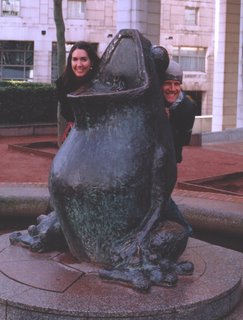A Scanner Darkly
Starting a couple weeks ago, Anne and I began shaping the consumer choices of millions of Americans. About six months ago, a database sequestered in a bunker somewhere in the Midwest deemed our household to be demographically desirable, and we were asked to join a consumer panel for A.C. Nielsen (the same company that does the TV ratings). After a couple-month wait for an open spot on the panel, we were sent a small scanner that we use to record all of our purchases. You know the set top boxes that record what TV shows you watch? This is a lot like that only 1,000x more intrusive.
The scanner is a small, hand-held device with a key pad and an infrared reader at the top. Everything we buy that has a barcode on it (groceries, CD's, camping gear ... anything) gets recorded. Also, many things we buy that don't have one also need to be recorded. For those, we have a 1/2" thick binder full of printed barcodes. For example, if I buy a bag of green beans, I open to the page of vegetables and scan the barcode printed underneath "Beans, green/string." I then enter the weight of the beans and the price per pound. There are also little barcodes to indicate if the beans were loose or bunched, and if they were organic or not.
If this sounds like a pain in the ass, that's because it is. We spend about 20 minutes after every trip to the grocery store scanning in our purchases. And the corner store where we buy most of our produce doesn't have a computerized inventory system, so every item on the receipt is called "Grocery." This creates a bit of a challenge when you have to scan in the weights and costs of each bag of fruits and veggies when you get back home. As for the veggie box we get from the farm, well, the weights and prices we enter for those items are basically a fiction.
Now I don't want to sound too down on the scanner. I do like the fact that our purchases may influence big food companies and grocers to sell more organic food and craft-brewed beer. Also, we earn points for scanning our purchases and transmitting the data back to A.C. Nielsen regularly, and the points can be redeemed for all sorts of stuff from a catalog. (We've got our eyes on the AeroBed.) Of course, if we were paid an hourly wage for our scanning time and then went out and bought the same items in the catalog (and scanned their barcodes, of course), it probably works out to us getting paid about 50 cents and hour, but nevertheless, at least we have something to strive for.
So, if the next time you're standing in the store looking at the beer cooler and wondering why all of the Budweiser has been replaced with Anderson Valley beers, you have us to thank.


0 Comments:
Post a Comment
<< Home